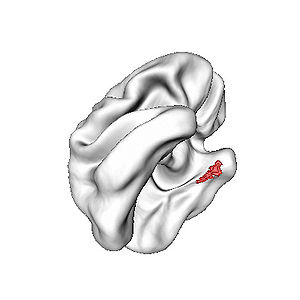Entorhinal cortex
| Entorhinal cortex | |
|---|---|
Inferior striate | |
| Identifiers | |
| Latin | cortex entorhinalis |
| MeSH | D018728 |
| NeuroNames | 168 |
| NeuroLex ID | birnlex_1508 |
| Anatomical terms of neuroanatomy] | |
The entorhinal cortex (EC) is an area of the brain's
Anatomy
The entorhinal cortex is a portion of the rostral parahippocampal gyrus.[2]
Structure
It is usually divided into
Connections

The superficial layers – layers II and III – of EC project to the dentate gyrus and hippocampus: Layer II projects primarily to dentate gyrus and hippocampal region CA3; layer III projects primarily to hippocampal region CA1 and the subiculum. These layers receive input from other cortical areas, especially associational, perirhinal, and parahippocampal cortices, as well as prefrontal cortex. EC as a whole, therefore, receives highly processed input from every sensory modality, as well as input relating to ongoing cognitive processes, though it should be stressed that, within EC, this information remains at least partially segregated.
The deep layers, especially layer V, receive one of the three main outputs of the hippocampus and, in turn, reciprocate connections from other cortical areas that project to superficial EC.
Brodmann's areas
- Brodmann area 28 is known as the "area entorhinalis"
- Brodmann area 34 is known as the "area entorhinalis dorsalis"
Function
Neuron information processing
In 2005, it was discovered that entorhinal cortex contains a neural map of the spatial environment in rats.[3] In 2014, John O'Keefe, May-Britt Moser and Edvard Moser received the Nobel Prize in Physiology or Medicine, partly because of this discovery.[4]
In rodents, neurons in the lateral entorhinal cortex exhibit little spatial selectivity,
The same group of researchers has found speed cells in the medial entorhinal cortex of rats. The speed of movement is translated from proprioceptive information and is represented as firing rates in these cells. The cells are known to fire in correlation to future speed of the rodent.[7]
Recently, a general theory has been proposed to elucidate the function of the
Single-unit recording of neurons in humans playing video games find path cells in the EC, the activity of which indicates whether a person is taking a clockwise or counterclockwise path. Such EC "direction" path cells show this directional activity irrespective of the location of where a person experiences themselves, which contrasts them to place cells in the hippocampus, which are activated by specific locations.[10]
EC neurons process general information such as directional activity in the environment, which contrasts to that of the hippocampal neurons, which usually encode information about specific places. This suggests that EC encodes general properties about current contexts that are then used by hippocampus to create unique representations from combinations of these properties.[10]
Research generally highlights a useful distinction in which the medial entorhinal cortex (MEC) mainly supports processing of space,[11] whereas the lateral entorhinal cortex (LEC) mainly supports the processing of time.[1]
The MEC exhibits a strong ~8 Hz
Individual variation in the volume of EC is linked to taste perception. People with a larger EC in the left hemisphere found quinine, the source of bitterness in tonic water, less bitter.[14]
Clinical significance
Alzheimer's disease
The entorhinal cortex is the first area of the brain to be affected in Alzheimer's disease; in year 2013, a functional magnetic resonance imaging study has localised the area to the lateral entorhinal cortex.[15] Lopez et al.[16] have shown, in a multimodal study, that there are differences in the volume of the left entorhinal cortex between progressing (to Alzheimer's disease) and stable mild cognitive impairment patients. These authors also found that the volume of the left entorhinal cortex inversely correlates with the level of alpha band phase synchronization between the right anterior cingulate and temporo-occipital regions.
In 2012, neuroscientists at
Research
Effect of aerobic exercise
A study on young subjects found aerobic fitness to be
In other animals
In rodents, the EC is located at the
In primates it is located at the rostral end of the temporal lobe and stretches dorsolaterally.
Additional images
-
Entorhinal cortex, shown in the right cerebral hemisphere.
References
- ^ a b Integrating time from experience in the lateral entorhinal cortex Albert Tsao, Jørgen Sugar, Li Lu, Cheng Wang, James J. Knierim, May-Britt Moser & Edvard I. Moser Naturevolume 561, pages57–62 (2018)
- ISBN 978-1-259-64248-7.
- ^ S2CID 4405184.
- ^ "Overview of Nobel Prize laureates in Physiology or Medicine".
- S2CID 24399770.
- PMID 15333832.
- S2CID 4404374.
- PMID 33013334.
- PMID 31839450.
- ^ PMID 20308554.
- S2CID 13774938.
- S2CID 4429491.
- PMID 32057292.
- PMID 30703394.
- PMID 24362760.
- PMID 25355209.
- PMID 22316444.
- ^ "Study highlights the importance of physical activity and aerobic exercise for healthy brain function". Retrieved 2017-12-04.
External links
- Stained brain slice images which include the "Entorhinal cortex" at the BrainMaps project
- NIF Search - Entorhinal Cortex via the Neuroscience Information Framework
- For delineating the Entorhinal cortex, see Desikan RS, Ségonne F, Fischl B, Quinn BT, Dickerson BC, Blacker D, Buckner RL, Dale AM, Maguire RP, Hyman BT, Albert MS, Killiany RJ. An automated labeling system for subdividing the human cerebral cortex on MRI scans into gyral based regions of interest. Neuroimage. 2006 Jul 1;31(3):968-80.

